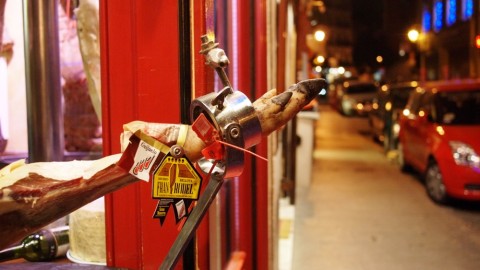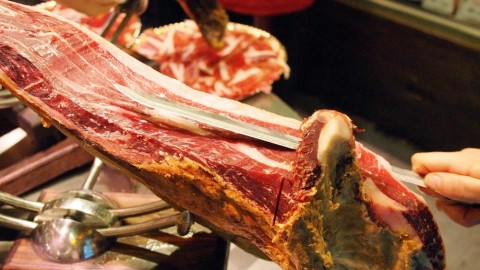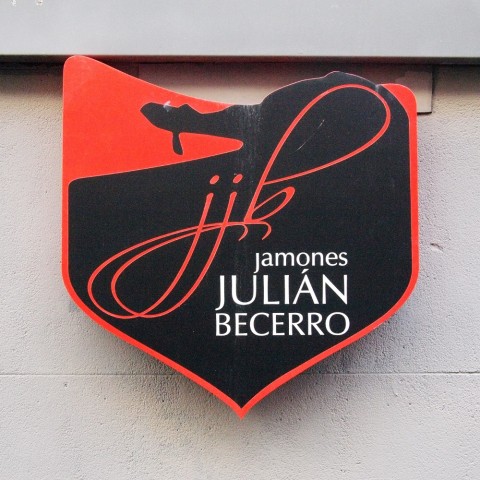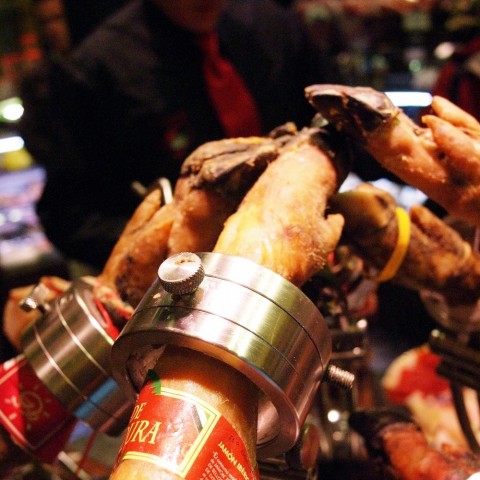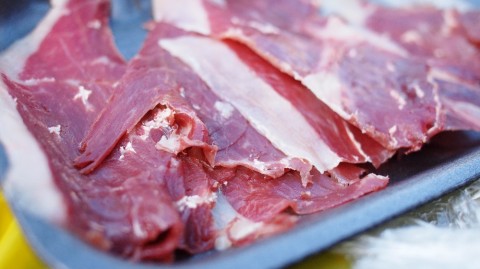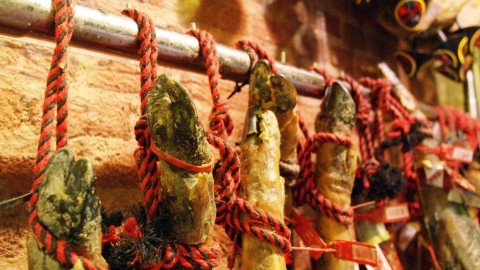I have, as you may have guessed about me already, a great deal of sympathy for ham obsession. I have myself, on a number of occasions, made the circuit in Philadelphia from the Reading Terminal Market, to the Di Bruno Brothers, to Claudio’s, looking for just the right crudo to pair with scallops, or melon, or whatever the experiment of the week might be. I have sampled five or six types, then settled on two or three, figuring that the ham I didn’t use would undoubtedly find a good home in some other project. Like my lunch. I wouldn’t say that I am an expert. Hardly. Rather, I would call myself an enthusiast for the cured leg of the pig. Because I am, if nothing else, very enthusiastic.
But enthusiasm can be a relative thing. And I think that I didn’t quite understand ham enthusiasm — ham obsession — until I spent some time in Spain.
Ham obsession is a serving of jamón, along side bacon, as part of a nutritious breakfast. It is a slice of jamón laid across a dry split baguette for lunch — because who needs a condiment? It is a ración of jamón at the top of every menu of every restaurant, tapas bar, and cervecería, often offered in several different sizes and levels of quality, for every occasion and every price point. It is a cab driver in Barcelona exclaiming in horror: “You mean that jamónes in the United States don’t have a hoof? But how can you tell whether they’re the [low-end] white kind, or the [premium] black kind? The black ones are so good!”
That kind of outburst — not from a chef or even a foodie — is what I mean by ham obsession. There is a kind of passion for jamón in Spain — a pain-pleasure thing that straddles the border between religion and sensuality — that I as an outsider can’t wholly understand. It is in part a Catholic thing. Famously, after the expulsion of the Muslims and then the Jews in the Middle Ages, pork consumption became a signifier of religious conformity — a sign, to the Inquisition among others, that I, good Spaniard, am not in need of your cruel ministrations.
But it’s more generalized than that, too. There is a kind of ritual about the consumption of jamón: ordering a ración, laid out on a platter in radiating circles; picking out just enough, held between the finger nails, to lay across a wafer of crusty bread; eating it with slow relish, accompanied by a glass of vino tinto, or sometimes café con leche. And there is a kind of delaying of gratification: the sweet suffering of customers at the deli counter or the bar, watching appreciatively as a skilled knifesman painstakingly hand-cuts slice after razor-thin slice, filling that platter at his own pace. No faster.
We could never love ham like that in the United States. We don’t have the devotion. We don’t know how to wait.
And frankly, we don’t really have the jamón. The fanciest pig parts that show up at Di Bruno’s or Claudio’s are good, more ore less. They have some of the creamy texture, some of the subtle flavor. They have some marbling of fat. But the best — at least Spain’s best — rarely leaves the country. Until 2005, the real jamón Ibérico, made from black Iberian pigs who foraged on acorns, was unavailable in the United States. Today, some comes in, but it is prohibitively expensive, and not the highest quality.
While I was in Madrid, I walked into a quality charcuteria — Julián Becerro, where a large number of the photos in this post were taken — and they made this point abundantly clear. I told them that I love jamón at home, and that I wanted to try something that I can’t get in the United States. And the clerks laughed at me. Pick anything in the store, they told me. There is nothing here that you can get in the United States.
And then a clerk walked me over to a wheel of jamónes, legs radiating out, their hoofs in stirrups, where knifesmen were cutting away. He explained to me in very limited English that each leg on the table was a different variety — fed differently, with a different provenance, flavor, and price point. He cut for me some samples, and I understood.
I ended up buying just a few slices of one variety of jamón bellota — an acorn-fed ham that was unlike anything I had tasted before, and certainly unlike anything I have ever gotten at home. In texture, it is silky, oily, fatty — like the best thin-sliced lox, almost like soft wax in a warm room. In flavor, it’s mild and creamy like other hams, but with an intense nuttiness, both sweet and slightly tannic, layered on top of that. It tasted like acorn, I would suggest, in the same way that really fresh milk tastes like pasture grass.
With our slices in hand, Sarah and I made our way from Julián Becerro, a couple of blocks to Madrid’s Plaza Mayor, where we sat ourselves down, tore open the wrapping, and ate the entire package with our fingers. Was it jamón obsession? I think not. Sarah has expressed that, with only a couple of exceptions, she *was not impressed* by a product that is as often very bad — served in stale, pre-packaged sandwiches in museum cafeterias — as it is very good. And even I, by the end of our journey, was wishing that some of the jamón, a little bit of the jamón, could be replaced by a fresh salad or some nice green kale.
But I would suggest that it is sympathy with ham obsession. After two weeks in Spain, eating jamón every day whether I wanted it or not, I don’t have the feeling that I’d like to go without it for a good long while. I don’t need a separation from ham, or time to remember that when it’s absent, I miss it. I like jamón. I am enthusiastic. And while I learned something about it’s relative quality from my time in Spain, I don’t plan to let that spoil my enthusiasm for ham at home.
